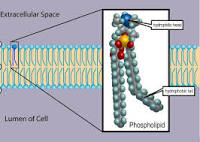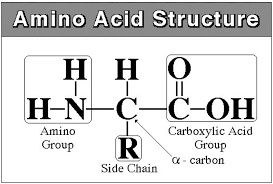
The Structure and Function of Macromolecules
Macromolecules
Are large molecules composed of smaller molecules
Are complex in their structure
Most macromolecules are polymers, built from monomers
Four classes of life’s organic molecules are polymers
Carbohydrates
Proteins
Nucleic acids
Lipids
A polymer
A long molecule consisting of many similar building blocks called monomers
Specific monomers make up each macromolecule
E.g. amino acids are the monomers for proteins
The Synthesis and Breakdown of Polymers
Monomers form larger molecules by condensation reaction called dehydration synthesis
Polymers and disassemble by hydrolysis
Addition of water molecules
Although organisms share the same limited number of monomer types, each organism is unique based on the arrangement of monomers into polymers
An immense variety of polymers can be built from a small set of monomers
Carbohydrates
Serve as fuel and building material
Include both sugars and polymers
Starch, cellulose, etc.
Sugars
Monosaccharides
Are the simplest sugars
Can be used for fuel
Can be converted into other organic molecules
Can be combined into polymers
Can be linear
Can form rings
Disaccharides
Consist of two monosaccharides
Are joined by a glycosidic linkage
Polysaccharides
Are polymers of sugars
Serve many roles in organism
Storage Polysaccharides
Starch
Is a polymer consisting entirely of glucose monomers
Is the major storage form of glucose in plants
Glycogen
Consists of glucose monomers
Is the major storage form of glucose in animals
Cellulose
Is a polymer of glucose
Has different glycosidic linkages than starch
Difficult to digest
Cows have microbes in their stomach to facilitate this process
Chitin
Is found in the exoskeleton of arthropods
Can be used as surgical thread
Lipids
Are the one class of large biological monomers that do not consist of polymers
Share the common trait of being hydrophobic
Fats
Constructed from two types of smaller molecules
A single glycerol and usually three fatty acids
Vary in length and number and location of double bonds they contain
Saturated fatty acids
Have the maximum number of hydrogen atoms possible
Have no double bonds
Unsaturated fatty acids
Have one or more double bonds
Phospholipids
Have only two fatty acids
Have a phosphate group instead of third fatty acid
Structure
Consists of a hydrophobic “head” and hydrophobic “tails”
Results in a bilayer arrangement founds in cell membranes

Steroids
Lipids characterized by a carbon skeleton consisting of four fused rings
Cholesterol
Found in cell membranes
Is a precursor for some hormones
Proteins
Proteins have many structures, resulting in a wide range of functions
Proteins do most of the work in cells and acts as enzymes
Proteins are made of monomers called amino acids
Enzyme
Type of protein that acts as a catalyst, speeding up chemical reactions
Polypeptides
Polymers of amino acids
A protein consists of one or more polypeptides
Amino acids
Are organic molecules possessing both carboxyl and amino groups
Differ in their properties due to differing side chains, called R groups
Linked by peptide bonds

Protein Conformation and Function
A protein’s specific conformation (shape) determines how it functions
Four Levels of Protein Structure
Primary structure
Unique sequence of amino acids in a polypeptide
Secondary structure
Folding or coiling of the polypeptide into a repeating configuration
Includes the a helix and β pleated sheet
Tertiary Structure
Overall three-dimensional shape of a polypeptide
Results from interactions between amino acids and R groups
Quaternary structure
The overall protein structure that results from the aggregation of two or more polypeptide subunits
Sickle Cell Disease
Results from a single amino acid substitution in the protein hemoglobin
What determines Protein Conformation
Protein conformation depends on the physical and chemical conditions of the protein’s environment
Temperature, pH, etc.
Denaturation is when a protein unravels and loses its native conformation
The Protein Folding Problem
Most proteins
Probably go through several intermediate states on their way to a stable conformation
Denaturated proteins no longer work in their unfolded conditions
Proteins may be denaturated by extreme changes in pH or temperature
Chaperonins
Protein molecules that assist in the proper folding of other proteins
X-ray crystallography
Used to determine a protein’s three-dimensional structure
Nucleic Acids
Store and transmit hereditary information
Genes
Are the units of inheritance
Program the amino acid sequence of polypeptides
Are made of nucleotide sequences of DNA
DNA
Deoxyribonucleic acid
Stores information for the synthesis of specific proteins
Found in the nucleus of the cell
Functions
Directs RNA synthesis
Transcription
Directs protein synthesis through RNA
Translation
Structure
Nucleic acids exist as polymers called polynucleotides
Each polynucleotide
Consists of monomers called nucleotides
Sugar + phosphate + nitrogen base
Nucleotide monomers
Made up of nucleosides (sugar + base) and a phosphate group
Nucleotide polymers
Are made up of nucleotides linked by the -OH on the 3’ carbon of one nucleotide and the phosphate on the 5’ carbon of the next
Gene
The sequence of bases along a nucleotide polymer
DNA double helix
Have two polynucleotides that spiral around an imaginary axis
Form a double helix
Consists of two antiparallel nucleotide strands
A, T, C, G
The nitrogenous bases in DNA
Form hydrogen bonds in a complementary fashion
A with T only
C with G only
DNA and Proteins as Tape Measures of Evolution
Molecular comparisons
Help biologists sort out the evolutionary connections among species
The Structure and Function of Macromolecules
Macromolecules
Are large molecules composed of smaller molecules
Are complex in their structure
Most macromolecules are polymers, built from monomers
Four classes of life’s organic molecules are polymers
Carbohydrates
Proteins
Nucleic acids
Lipids
A polymer
A long molecule consisting of many similar building blocks called monomers
Specific monomers make up each macromolecule
E.g. amino acids are the monomers for proteins
The Synthesis and Breakdown of Polymers
Monomers form larger molecules by condensation reaction called dehydration synthesis
Polymers and disassemble by hydrolysis
Addition of water molecules
Although organisms share the same limited number of monomer types, each organism is unique based on the arrangement of monomers into polymers
An immense variety of polymers can be built from a small set of monomers
Carbohydrates
Serve as fuel and building material
Include both sugars and polymers
Starch, cellulose, etc.
Sugars
Monosaccharides
Are the simplest sugars
Can be used for fuel
Can be converted into other organic molecules
Can be combined into polymers
Can be linear
Can form rings
Disaccharides
Consist of two monosaccharides
Are joined by a glycosidic linkage
Polysaccharides
Are polymers of sugars
Serve many roles in organism
Storage Polysaccharides
Starch
Is a polymer consisting entirely of glucose monomers
Is the major storage form of glucose in plants
Glycogen
Consists of glucose monomers
Is the major storage form of glucose in animals
Cellulose
Is a polymer of glucose
Has different glycosidic linkages than starch
Difficult to digest
Cows have microbes in their stomach to facilitate this process
Chitin
Is found in the exoskeleton of arthropods
Can be used as surgical thread
Lipids
Are the one class of large biological monomers that do not consist of polymers
Share the common trait of being hydrophobic
Fats
Constructed from two types of smaller molecules
A single glycerol and usually three fatty acids
Vary in length and number and location of double bonds they contain
Saturated fatty acids
Have the maximum number of hydrogen atoms possible
Have no double bonds
Unsaturated fatty acids
Have one or more double bonds
Phospholipids
Have only two fatty acids
Have a phosphate group instead of third fatty acid
Structure
Consists of a hydrophobic “head” and hydrophobic “tails”
Results in a bilayer arrangement founds in cell membranes

Steroids
Lipids characterized by a carbon skeleton consisting of four fused rings
Cholesterol
Found in cell membranes
Is a precursor for some hormones
Proteins
Proteins have many structures, resulting in a wide range of functions
Proteins do most of the work in cells and acts as enzymes
Proteins are made of monomers called amino acids
Enzyme
Type of protein that acts as a catalyst, speeding up chemical reactions
Polypeptides
Polymers of amino acids
A protein consists of one or more polypeptides
Amino acids
Are organic molecules possessing both carboxyl and amino groups
Differ in their properties due to differing side chains, called R groups
Linked by peptide bonds

Protein Conformation and Function
A protein’s specific conformation (shape) determines how it functions
Four Levels of Protein Structure
Primary structure
Unique sequence of amino acids in a polypeptide
Secondary structure
Folding or coiling of the polypeptide into a repeating configuration
Includes the a helix and β pleated sheet
Tertiary Structure
Overall three-dimensional shape of a polypeptide
Results from interactions between amino acids and R groups
Quaternary structure
The overall protein structure that results from the aggregation of two or more polypeptide subunits
Sickle Cell Disease
Results from a single amino acid substitution in the protein hemoglobin
What determines Protein Conformation
Protein conformation depends on the physical and chemical conditions of the protein’s environment
Temperature, pH, etc.
Denaturation is when a protein unravels and loses its native conformation
The Protein Folding Problem
Most proteins
Probably go through several intermediate states on their way to a stable conformation
Denaturated proteins no longer work in their unfolded conditions
Proteins may be denaturated by extreme changes in pH or temperature
Chaperonins
Protein molecules that assist in the proper folding of other proteins
X-ray crystallography
Used to determine a protein’s three-dimensional structure
Nucleic Acids
Store and transmit hereditary information
Genes
Are the units of inheritance
Program the amino acid sequence of polypeptides
Are made of nucleotide sequences of DNA
DNA
Deoxyribonucleic acid
Stores information for the synthesis of specific proteins
Found in the nucleus of the cell
Functions
Directs RNA synthesis
Transcription
Directs protein synthesis through RNA
Translation
Structure
Nucleic acids exist as polymers called polynucleotides
Each polynucleotide
Consists of monomers called nucleotides
Sugar + phosphate + nitrogen base
Nucleotide monomers
Made up of nucleosides (sugar + base) and a phosphate group
Nucleotide polymers
Are made up of nucleotides linked by the -OH on the 3’ carbon of one nucleotide and the phosphate on the 5’ carbon of the next
Gene
The sequence of bases along a nucleotide polymer
DNA double helix
Have two polynucleotides that spiral around an imaginary axis
Form a double helix
Consists of two antiparallel nucleotide strands
A, T, C, G
The nitrogenous bases in DNA
Form hydrogen bonds in a complementary fashion
A with T only
C with G only
DNA and Proteins as Tape Measures of Evolution
Molecular comparisons
Help biologists sort out the evolutionary connections among species
 Knowt
Knowt